Search Results for: satan
Book Deal Announcement: “The Little Book of Satanism” by La Carmina! Ulysses / Simon & Schuster, Satanic guidebook.
A devilish announcement: I have a new book coming out… about SATANISM! It’ll be published October 25 by Ulysses Press / Simon & Schuster!
Late last year, I received a book deal for The Little Book of Satanism: a nonfiction guide to the history, culture, and practices of Satanism. My fourth book features a foreword by Lucien Greaves of The Satanic Temple, and will be released by Simon & Schuster on 10/25.
♥ PREORDER NOW — The Little Book of Satanism: A Guide to Satanic History, Culture & Wisdom is available for preordering on Amazon. My book is also available at Barnes and Noble, Bookshop, and other retailers worldwide. Canadians can find it via Chapters/Indigo or Amazon Canada.

♥ TO SUPPORT — Please keep reading to see the Baphomet cover art, contents, and more. And thank you for taking a moment to share this post on social media — I appreciate your help in getting the word out!

❤ What is the book about?
The Little Book of Satanism by La Carmina is an accessible overview of Satanic history and culture that aims to dispel misconceptions about modern Satanists. The book begins with a foreword by Lucien Greaves (of The Satanic Temple), and then introduces the Devil’s conceptualization from his Ancient Near East predecessors to the Bible and beyond. I trace Satan’s historic footprint through the centuries (the Knights Templar, Salem Witch Trials, Hellfire clubs, Aleister Crowley), to the birth of modern Satanism (LaVey’s The Church of Satan, and TST). I also cover the meaning behind Satanic sigils, the Devil in art / literature / pop culture, Satanic rituals and holidays, the Satanic Panic, and much more. (Full details further below.)
❤ Where and when can I get your book?
The Little Book of Satanism hits bookstores on October 25, 2022 — it’ll be available worldwide in both print and digital. You can pre-order my book now from Amazon, or get it from Kindle, Barnes and Noble, Bookshop, and other retailers worldwide, such as Canada’s Chapters/Indigo or Amazon Canada.
❤ How much does it cost?
Only $10.99 US for the digital version, and $14.95 US for the paperback. My book is available internationally at the links above, and can be preordered now. (Thank you for supporting!)

❤ Can you tell me more details about the book?
The following is the catalog copy for “The Little Book of Satanism: A Guide to Satanic History, Culture, and Wisdom” – by La Carmina.
Discover the fascinating history and culture of Satanism through the ages and learn why many Satanists today stand up for free inquiry and personal liberty.
Satanism is too often misunderstood as a religion that makes blood sacrifices to an evil, horned Prince of Darkness. In reality, modern Satanists are nonviolent and nontheistic, and consider the Devil to be a meaningful metaphor for the pursuit of knowledge, reason, and justice.
The Little Book of Satanism details the “mark of the beast” in cultural and historic movements over the centuries, which have informed the sincerely held beliefs and practices of Satanists today. Written by award-winning alternative culture journalist and blogger La Carmina, this comprehensive guide includes:
♥ A foreword from Lucien Greaves, activist, spokesperson, and cofounder of The Satanic Temple
♥ Information on Satan’s biblical origins, and his various names, appearances, and symbols
♥ Details on his age-old role as a scapegoat, from medieval witch trials to the 1980s Satanic Panic
♥ An overview of modern philosophy and practices, focusing on The Church of Satan, The Satanic Bible, and The Satanic Temple
♥ Examples of the Devil’s influence on art, literature, music, and films—from Paradise Lost to Rosemary’s Baby
This accessible book explains how Satanism developed in the context of social history while debunking lurid conspiracy theories about serial killers and ritual abuse. It includes a primer on various Satanic practices such as social activism, rituals, and holidays. In the spirit of the fallen angel Lucifer, be inspired by Satanism’s affirmative values that courageously oppose arbitrary authority and champion nonconformity.

❤ Can I see the book cover design? Who made it?
Above is the cover art of The Little Book of Satanism! Lucien Greaves contributed ideas for the book cover design, including the block effect and a Baphomet with gentle eyes. The execution is by the Ulysses Press design team. Thank you to my Pirate – artist Naomi Rubin – for her in-depth feedback on the cover and layout.

❤ May I take a look inside?
Here’s a sneak peek at the inner pages, which incorporate Gothic fonts and inverted pentagrams. The Little Book of Satanism is 144 pages long, and includes black and white illustrations (like Stanislas de Guaita’s goat head in an inverted pentagram).
My book is in the catalog of major publisher Simon & Schuster, which put up a La Carmina author page here.
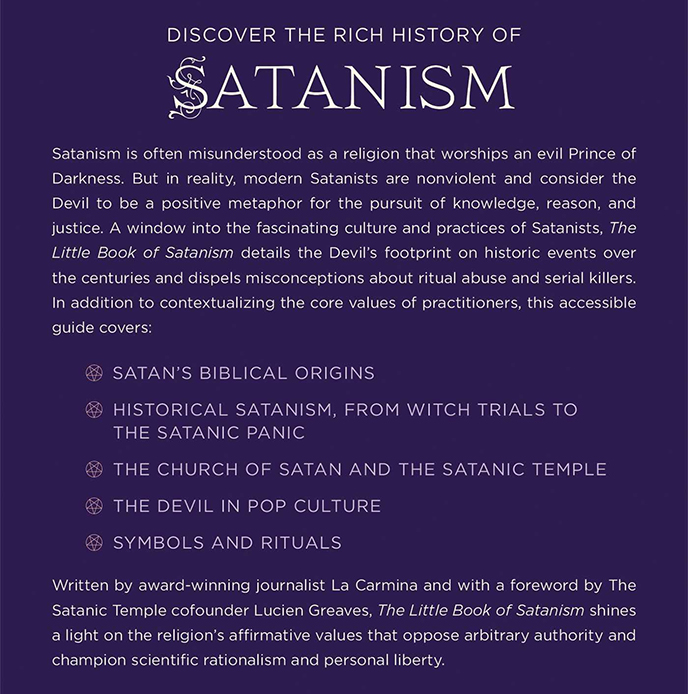
And here is the back cover copy, which invites you to discover the rich history of Satanism.
“Written by award-winning journalist La Carmina and with a foreword by The Satanic Temple cofounder Lucien Greaves, The Little Book of Satanism shines a light on the religion’s affirmative values that oppose arbitrary authority and champion scientific rationalism and personal liberty.”
144 pages / $14.95 / Preorder via Amazon or Simon & Schuster (various links to retailers).
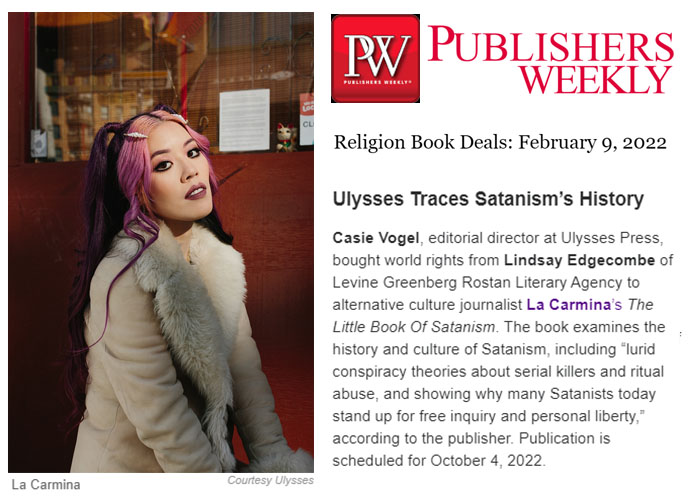
My book deal was announced in Publisher’s Marketplace and Publisher’s Weekly book deals announcements, in the Religion section. Thank you to my literary agent and to the Ulysses team for making this project possible. The article says:
“Ulysses Traces Satanism’s History. Casie Vogel, editorial director at Ulysses Press, bought world rights from Lindsay Edgecombe of Levine Greenberg Rostan Literary Agency to alternative culture journalist La Carmina’s The Little Book Of Satanism. The book examines the history and culture of Satanism, including “lurid conspiracy theories about serial killers and ritual abuse, and showing why many Satanists today stand up for free inquiry and personal liberty,” according to the publisher.”

I wanted to give a special shout-out to my friend Dr John Skutlin (who wrote about Satanism in his Ph.D. dissertation) for his hours of support throughout every stage of the manuscript. I’m thankful for the time he generously took to give me in-depth feedback and edits — the book wouldn’t have made it to the final draft without his expertise in these hellish matters!

It’s been a while since I’ve written a book, and it’s a joy to be back at it. This will be my fourth published book — my previous two were about Japanese pop culture (Cute Yummy Time and Crazy, Wacky Theme Restaurants, published by Penguin Random House.) If you’re curious, you can see my past La Carmina books here.
I’ve written extensively about Satanism since 2007, particularly about TST and the subculture in Japan — so I’m grateful for the opportunity to do a full-length book. My Satanic articles over the years have included:
♥ Fodor’s Travel: Profile of The Satanic Chef.
♥ The Daily Beast Travel: The most devilish destinations worldwide.
♥ Roadtrippers Magazine: Inside the TST Salem, MA art gallery and headquarters, with Lucien Greaves.
♥ Tripsavvy: Travel article about how to visit The Satanic Temple HQ.
♥ Unilad: La Carmina interviewed about the ongoing Satanic Panic.

One could say that I’ve been stepping on goat heads in pentagrams for quite some time now…
♥ I spoke about Satanism on various podcasts: La Carmina on Black Mass Appeal, Tea Room Dialogues, Satanic Study Hall, and Cemetery Confessions / The Belfry Network.
♥ I have over a decade of blog articles about Satanism worldwide, on my La Carmina blog. These include my firsthand reports of visiting The Satanic Temple in Salem, going to a Satanic disco party in London, hailing the Madrid Lucifer fountain, descending into Osaka’s Territory shop and Kobe’s IDEA Satanic bar, and more.

To commemorate the book deal signing, Joey Wong shot these images of me in Vancouver, using my new Sony a7 IV mirrorless camera.

Outfit details: Knee-high leather boots by L’Atelier de Charlotte (this women-run indie company designs shoes in London, and constructs them in Spain.) Cropped black sweater and houndstooth skirt from Fashion Chingu (they carry over 1000 items inspired by K-dramas and Kpop idols).

Handwoven mandalay silk headband by Thread Tales Company. The gold necklace is a large Safety Chain Choker by Eddie Borgo.
I can’t wait for you to read my new book, The Little Book of Satanism, when it comes out on Oct 25! If you have any questions about it, please leave me a blog comment. You can also connect with me on my @LaCarmina social media: Instagram / Twitter / Facebook Page — and shop items from my wardrobe on Depop @lacarmina.

And you’re welcome to check out my previous books from Penguin Random House: Cute Yummy Time (a guide to making meals look adorable) and Crazy, Wacky Theme Restaurants: Tokyo (exploring the bizarre world of Japanese maid cafes, cat cafes, vampire restaurants and more.)

PRE-ORDER The Little Book of Satanism on Amazon or Kindle or Barnes and Noble or through Simon & Schuster. Canadians can get it through Chapters/Indigo or Amazon Canada. It will be released October 25th, 2022.
The Little Book of Satanism by La Carmina drops 10/25/2022!

Thank you to all who made this dream writing project possible. Ave Satanas!
♥ Contact La Carmina: If you want to interview me about the book or have any questions, email me at gothiccarmina — att — gmail — dotcom
♥ And THANK YOU for preordering, and sharing my book news on social media (you can find me @LaCarmina). I’m grateful for your support over the years!
SHARE & COMMENT
Goth Madrid, Spain! Pavilions Hotel review, Lucifer Fallen Angel fountain: Retiro Park Satanic sculpture, Robot Museum.
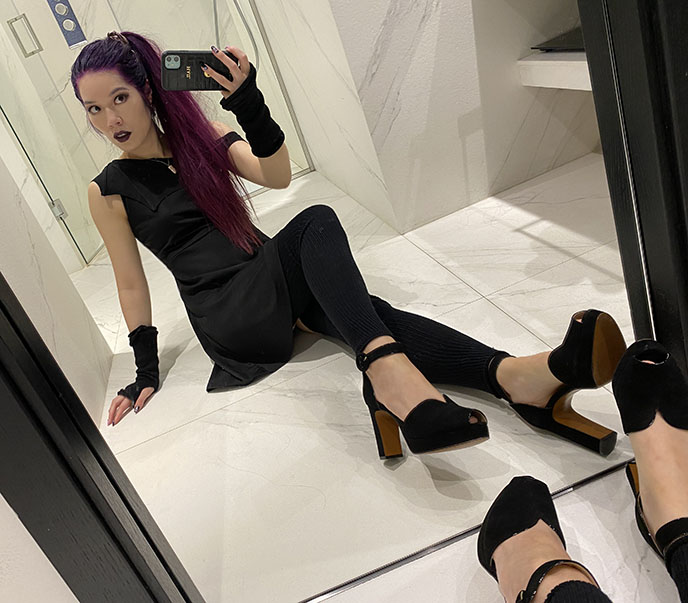
It wasn’t until my third trip to Spain that I discovered… I’m mad about Madrid!
Many travellers overlook the Spanish capital in favor of cities like Barcelona and Granada (which is what I did, on my previous two trips). This time, I spent a few days in Madrid — and realized it’s a wicked destination for those who love dark art, parks, culture and architecture (like this Goth girl).
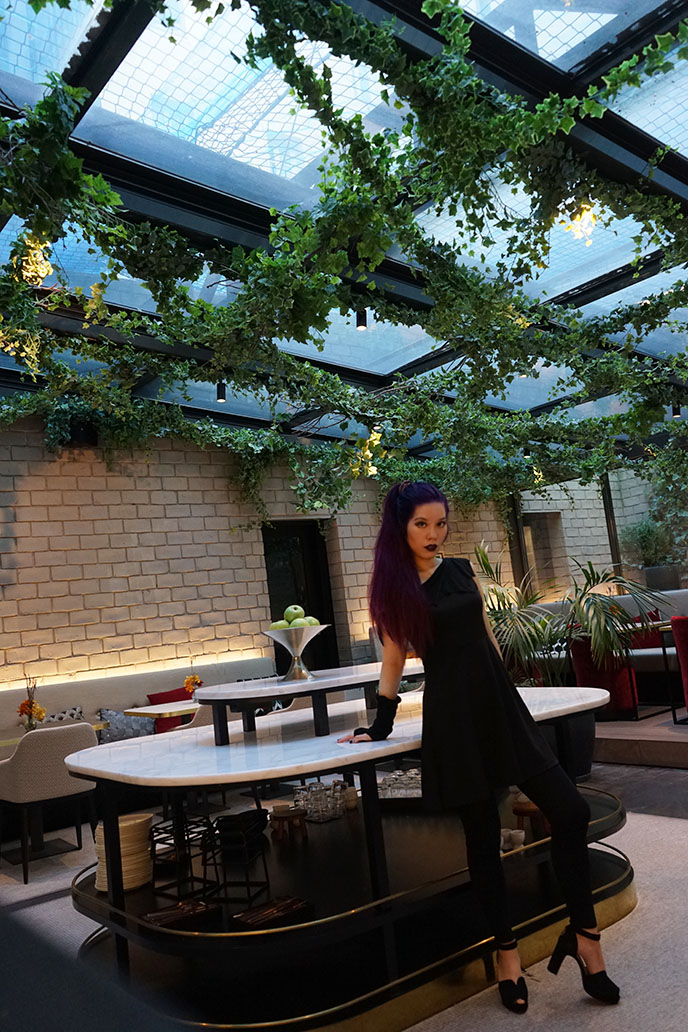
Read on for my stylish stay at The Pavilions Madrid hotel (wearing a Gothic one-shoulder dress by Fantasmagoria)…

… and a visit to a 19th century monument to Satan! (This is the Fallen Angel Fountain at Madrid’s Retiro Park. Inspired by John Milton’s “Paradise Lost,” the dramatic sculpture represents the angel Lucifer falling from Heaven, with gargoyles and demons below.)

I’ll also walk you though my stress-free PCR testing experience at MedMeSafe, and give you a tour of the funky Robot Museum Jugetronica. (Already, I think you can see why I loved Madrid…)
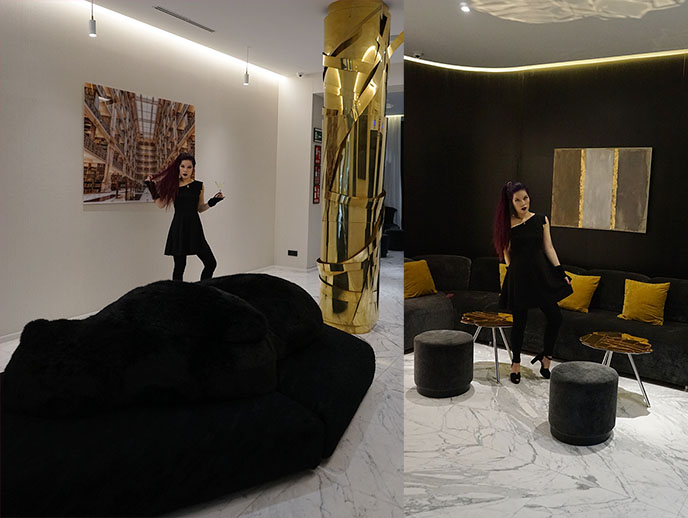
Let’s check in to my chic boutique hotel, The Pavilions Madrid, which has enticing avantgarde interiors. The luxurious hotel has a small number of rooms and friendly staff members, making my stay feel like a private getaway. Pavilions is located in a quiet and stately neighborhood of Madrid (Chamberi / Salamanca), yet it’s within walking distance to fashion boutiques, wine shops and cultural attractions.
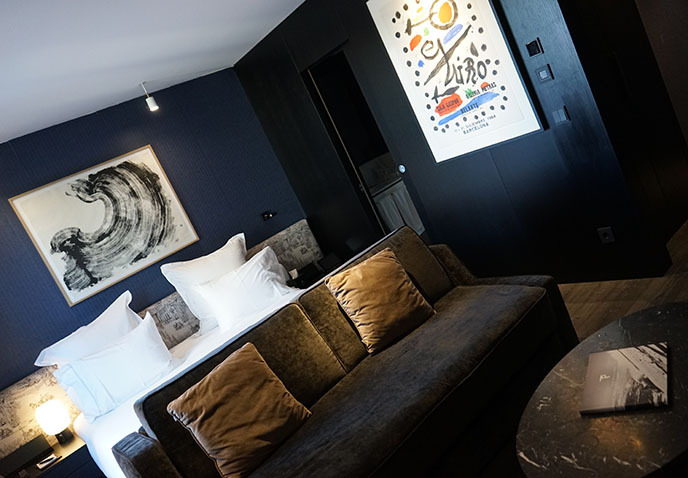
The hotel treated me to a top floor Deluxe Attic room, which is filled with Spanish contemporary art and includes a cozy bed, sofa, and modern bathroom.
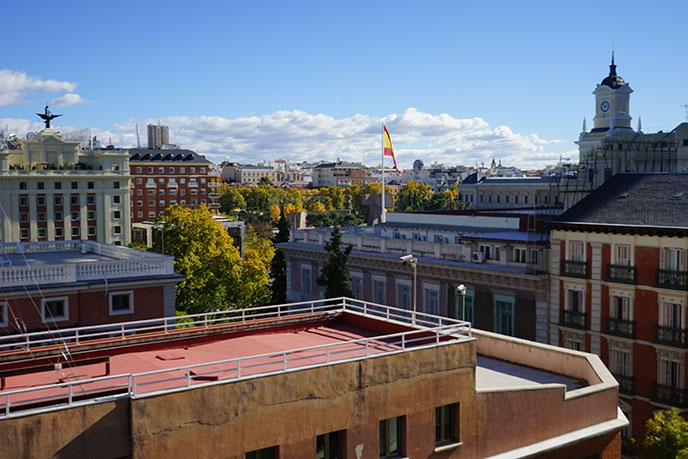
The best part… my room had a spacious terrace, with this view of the neighborhood and its classic architecture!

My “curated journey” at The Pavilions Madrid included lounging in the interior garden. Guests can enjoy cocktails and daily breakfast in this gorgeous green space.
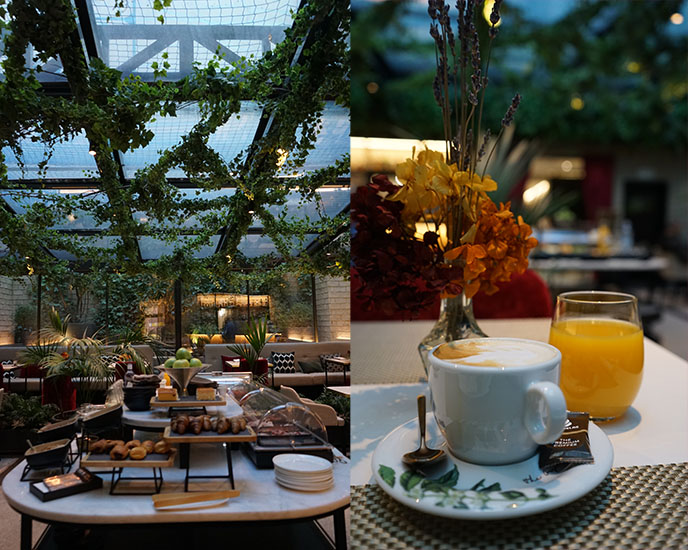
Can’t get enough of the breakfast nook, which has trailing plants hanging from the ceilings and walls. Every morning, I enjoyed fresh cafe au laits and eggs made to order, along with a selection of local cheeses, fruits, grain breads and more. (Be sure to try the quince paste, and tomato jam.)

In the afternoon, I kicked back with colorful drinks by bartender Gemma. Her creations include a salt-rim margarita, gin fizz, and rainbow citrus cocktail. (Keep reading for more of my stay at The Pavilions Madrid at the end of this story…)

I’m sure you are curious — what was it like to do a PCR test in Spain?
Many foreign visitors — including all Canadians — must now take a PCR or NAAT test in order to travel home (72 hours before you fly, and with a negative result of course).
Booking a PCR test can be complicated in Spain, as many clinics don’t speak English or offer an easy online system. I was relieved to discover MedMeSafe, an English-language platform with dozens of lab locations throughout Spain!
If you need an RT-PCR test in Spain, all you have to do is create a profile at MedMeSafe.com, enter your info, and select a time slot at a clinic near you (mine was centrally located in Madrid). The website is available in English, Spanish and French. You’ll get a voucher by email, which you show when you arrive. A professional performs a quick and non-invasive nasal swab, and it’s over in minutes. I received my results within 24 hours, which included a PDF letter, and I was good to go.
The MedMeSafe site has useful info, such as requirements to travel from Spain to Canada. In addition, the staff speaks English and is wonderful at responding quickly (by email and What’s App). Thank you to the team for the efficient and seamless PCR test experience. (You can find out more and book a test at a Spain lab here.)
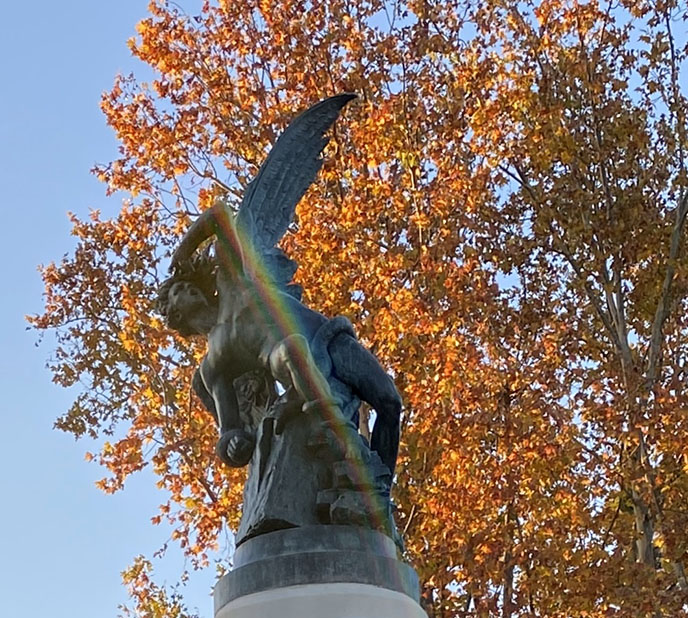
I spent my time in Madrid walking around different neighborhoods. (And walk I did… my iPhone tells me I averaged 20 – 24k steps per day!)
Of course, I made a pilgrimage to the devilish Fuente del Ángel Caído (Fountain of the Fallen Angel), located in Buen Retiro Park. It’s one of only monuments in the world dedicated to the overlord of Hell — hail Satan. The 1877 bronze sculpture shows the beautiful winged Lucifer falling from grace; it’s a masterpiece by Spanish sculptor Ricardo Bellver.
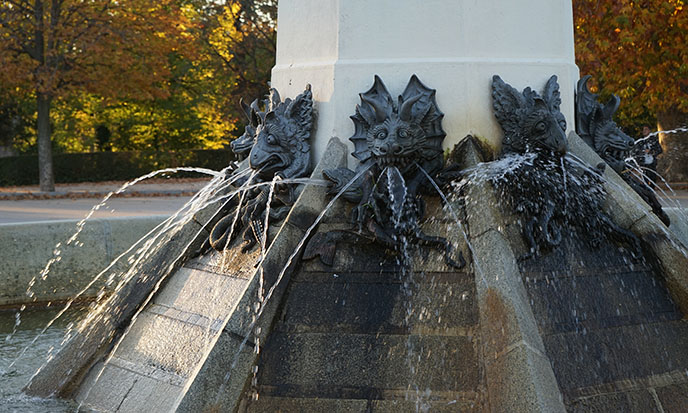
The Satanic fountain has an octagonal pedestal, which is decorated with dark demonic figures, lizards and snakes. I think these hell-beings look rather adorable, with water spurting from their fanged mouths.
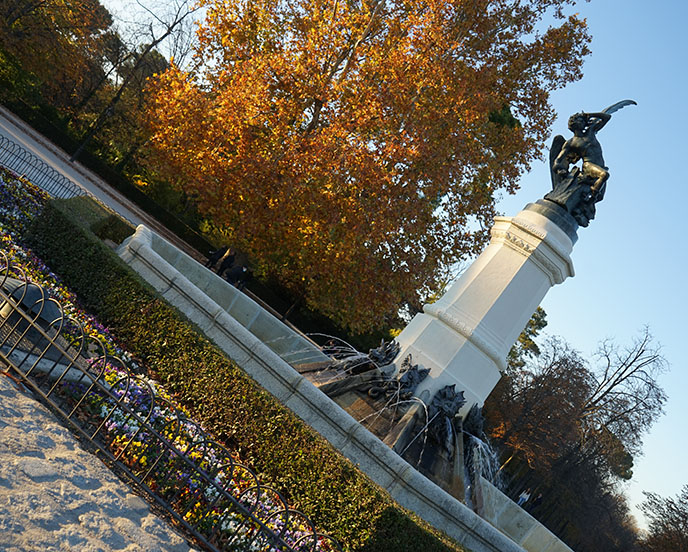
Located by the south central entrance of Madrid’s Retiro Park, the Fountain of the Fallen Angel stands 666 meters above sea level (a tribute to the number of the beast). What a wonderful artistic interpretation of Milton’s Paradise Lost.

I couldn’t get enough of Retiro Park, and spent hours here. Founded in 1505, this garden of Eden belonged to the Spanish monarchy until the late 19th century, when it became a public space.
Look for the pink Little Fisherman House (Casita del Pescador), built by a pond by King Ferdinand VII. I said hello to the ducks basking in the sun, and resident prowling cats. (The birds paid them no notice; it turns out that the animals are friends).
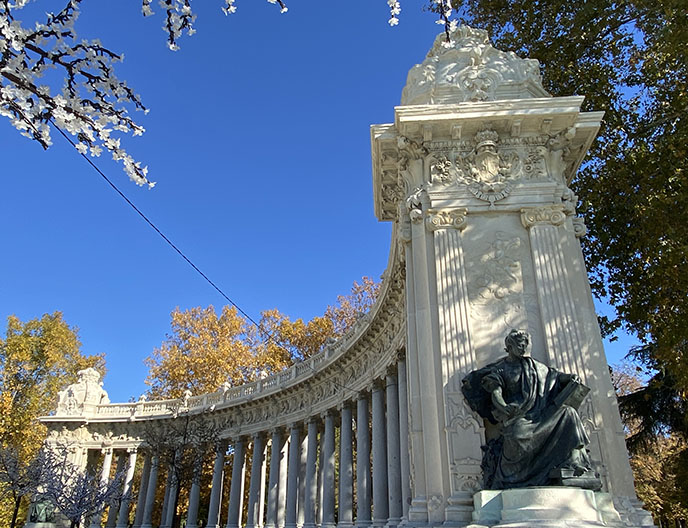
The former royal retreat spans 350 acres, and includes rose gardens and sculptures throughout. This is the King Alfonso XII monument…

… which is protected by proud lion statues that overlook the water.
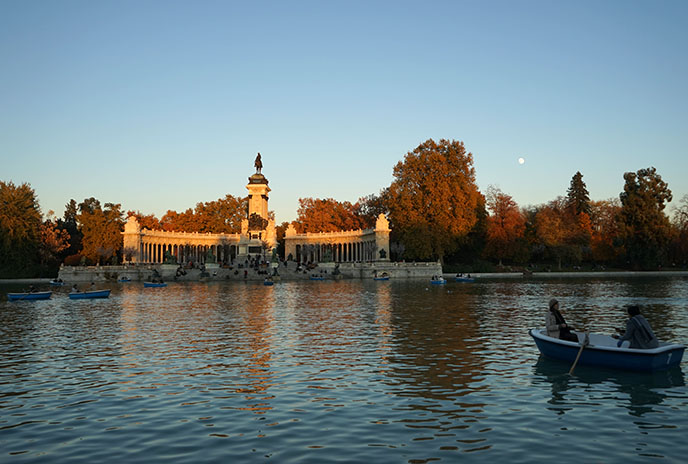
I watched couples rowing boats on Parque del Buen Retiro’s artificial lake. In the 17th century, the Spanish royals held water shows and mock battles here.
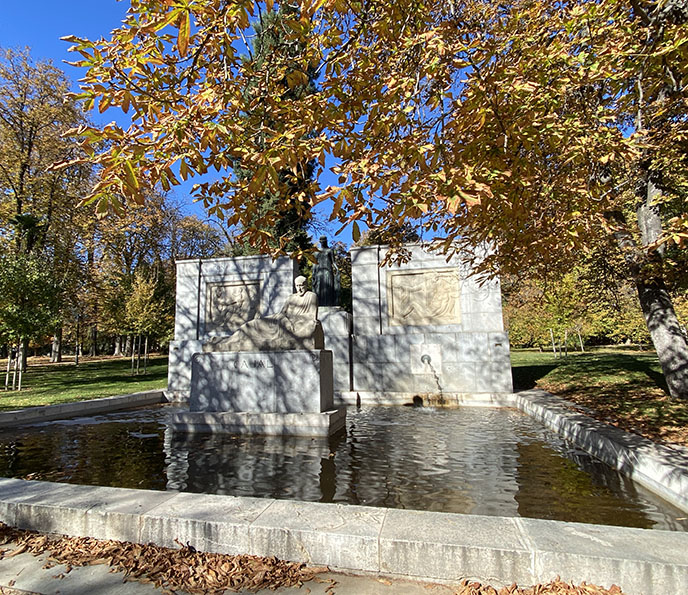
I loved strolling around and admiring the elegant fountains. This “Monument to Santiago Ramón y Cajal” was another favorite. The Art Deco reliefs show the goddess Minerva, and reference both human life and death.
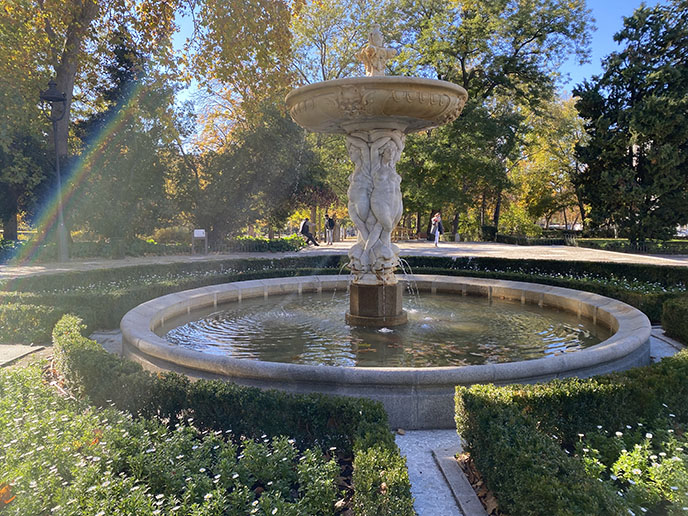
The brilliant light and water reflections made me feel like I was in a lucid dream. So glad I got to experience Madrid’s Retiro Park in November, for a last taste of fall.

It’s no secret that I am a fan of offbeat and bizarre museums / attractions — as well as robots. Put the two together, and you’ve got the funky Robot Museum Jugetronica!
Located inside Madrid’s Centro Comercial ABC Serrano shopping complex, the Robot Museum has an enormous collection of automatons from throughout the years. The resident “robotos” include Softbank’s Pepper (a humanoid and programmable bot), and Honda’s Asimo (which can perform the difficult task of climbing stairs).

I was fascinated by the wide variety of robots from different countries, including advanced automatons by Spain’s Juguetrónica. Of course, Japan is responsible for some of the cutest ones, like Sony’s Aibo the robot dog.

Aibo was big in Japan in the 2000s, and spawned many canine “breeds” and a fan magazine. The Robot Museum lets you play with a number of models, which is something I’d never had the chance to do before. I had fun petting an Aibo (who responded by wagging his tail), and having him chase a ball.

The museum gives a run-down of robots in pop culture that have captured our imaginations. These include Lost in Space, C3P0 of Star Wars, Terminator, and Japanese gundam (I saw a giant one in Tokyo).

I was particularly amused by the kawaii robots, which look like penguins, dinosaurs and other cute animals. Here’s Paro the therapeutic white seal, who comforted the elderly in Japanese care homes. (I want one!)

The robots can dance to the beat of music, respond to your commands, walk towards their master… I wonder, do these androids dream of electric sheep?

From the earliest incarnations (Medieval mechanical automatons) to today’s AI, robots have long fascinated and frightened humanity. Here are some retro bot toys from the 1970s.

The 1980s robots were my favorites. They’re clunky with buttons, and programmed through cassettes!

When it was released in the mid-80s, Tomy’s Omnibot 2000 was ahead of its time (on the left). Today, companies like Juguetrónica keep on blazing forward with artificial intelligence designs. Domo arigato, Mr Roboto, for the tour of the Robot Museum.
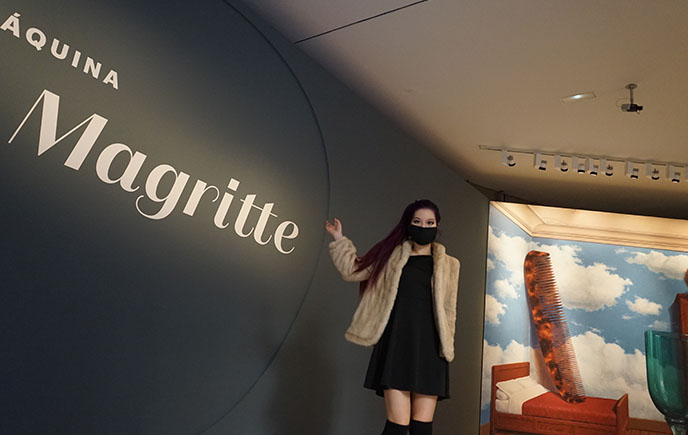
Madrid is one of Europe’s centers of art and culture. I ducked in to the Thyssen-Bornemisza Museum, which is part of the city’s “Golden Triangle of Art” (along with the Prado and the Reina Sofia national galleries).

The Thyssen has an outstanding collection of European art throughout the ages. When I visited, they had a special Rene Magritte surrealist retrospective. (I dig his strange visions, and have also been to the Magritte Museum in Brussels, Belgium.)
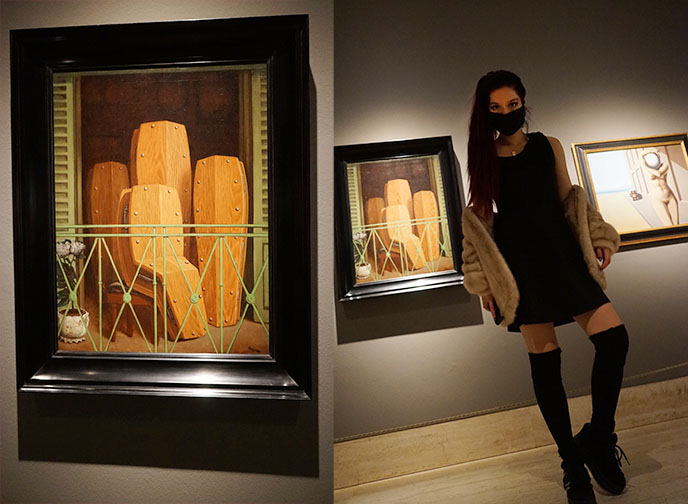
Magritte’s works are head-scratchers. I’m drawn to his more morbid paintings, such as this “family” of wooden coffins. (It’s called “Perspective II, Manet’s Balcony.”)
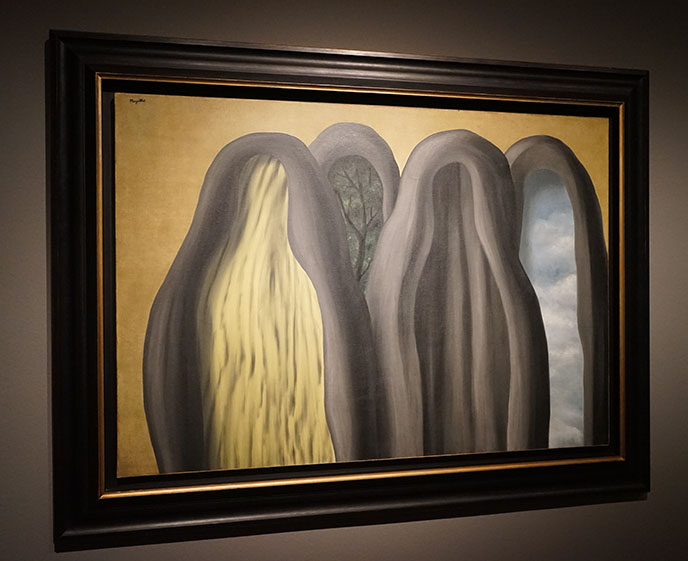
Magritte’s surrealism is masterful. These spooky shrouds look like portals into other universes.
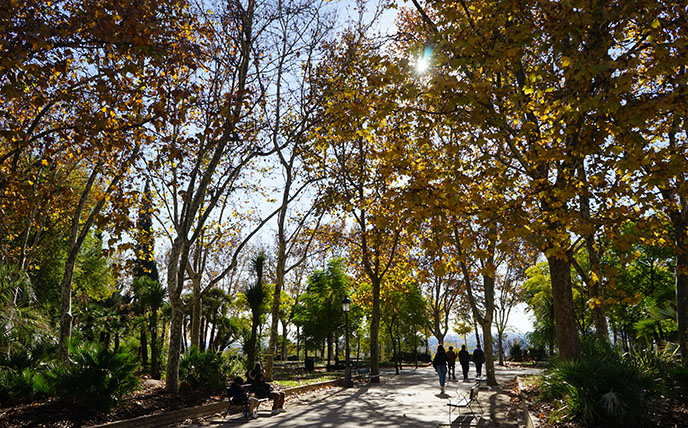
Being able to travel abroad and wander around a new city felt like a dream to me, in these complicated and ever-changing times.

Madrid has many free outdoor attractions, such as the Temple of Debod. This ancient Egyptian ruins came from Aswan, and were preserved here in 1968. (I have fond memories of visiting Abu Simbel in Aswan, Egypt…)
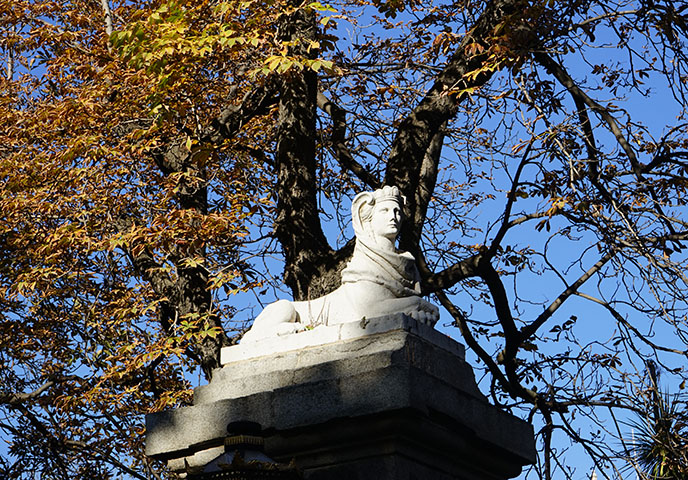
No matter where you wander in Madrid, you’ll see beautiful sculptures and architecture — like this Sphinx on top of a gate.
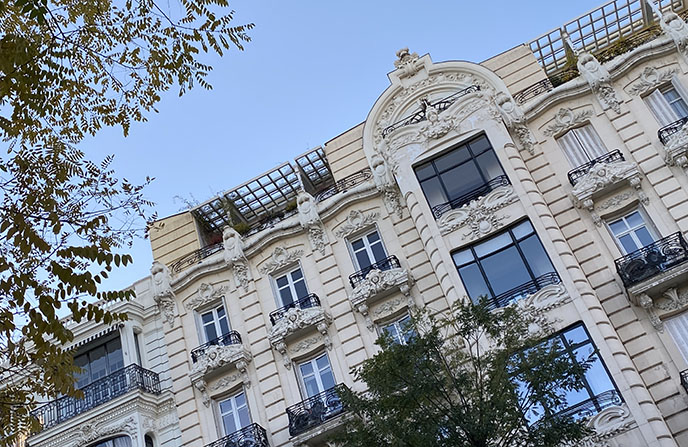
I couldn’t get enough of the ornate, carved facades. Imagine living in one of these apartments…

Along the wide shopping boulevard of Gran Via (known as “Spanish Broadway”), I spotted a double-fish fountain. I also encountered many “Maid of Honor” statues throughout Madrid, each uniquely and colorfully decorated. They’re a modern tribute to the ladies of Diego Velázquez’s famous “Las Meninas” painting.

Classic art is everywhere in the capital of Spain. I encourage you to walk around, and see what you discover.
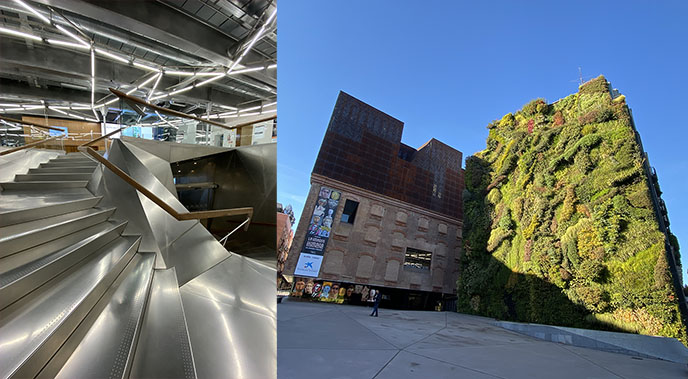
For avantgarde architecture, check out the CaixaForum Madrid museum and cultural center. The exterior features a stunning Vertical Garden living wall.
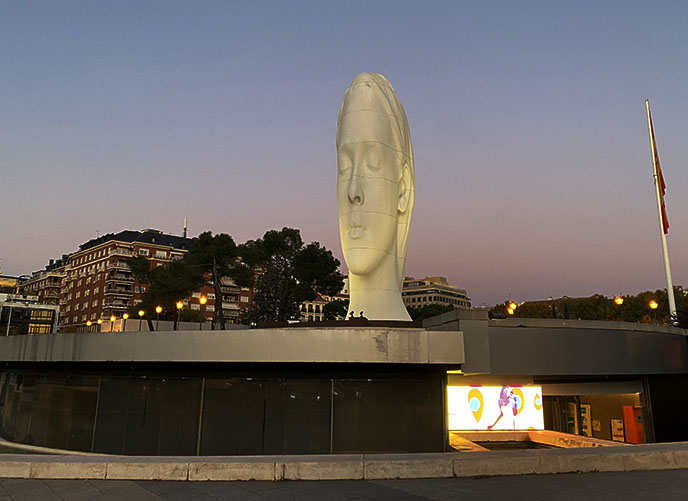
Madrid has a weird side as well. Meet “Julia” by Jaume Plensa, a giant sculpture of a woman’s head by the Fernán Gómez cultural center.

Back to my designer suite at The Pavilions Madrid (wearing a bat wing one-shoulder Goth dress by Fantasmagoria). This luxurious hotel turned out to be the perfect home base for my long walks around Madrid.
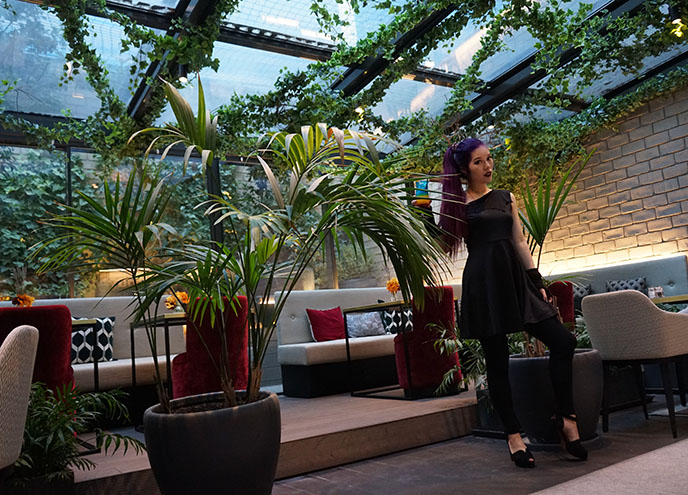
After two years in North America, being in Europe felt like a breath of fresh air. Gracias to everyone in Spain who welcomed me and made these experiences possible — including MedMeSafe Madrid for the rapid PCR test.
I’ll soon be sharing much more from Seville, Cordoba and Valencia, including Michelin-starred dining. Please check out my @lacarmina Instagram for updates. You can also review my previous blog posts about Barcelona and Granada, Spain here.
And finally, I was interviewed by Conde Nast Traveler about women and travel spending habits. I talk about how I want to return to Japan and Hong Kong, as soon as it’s possible… See my interview in CN Traveller Magazine.


 LA CARMINA
LA CARMINA






